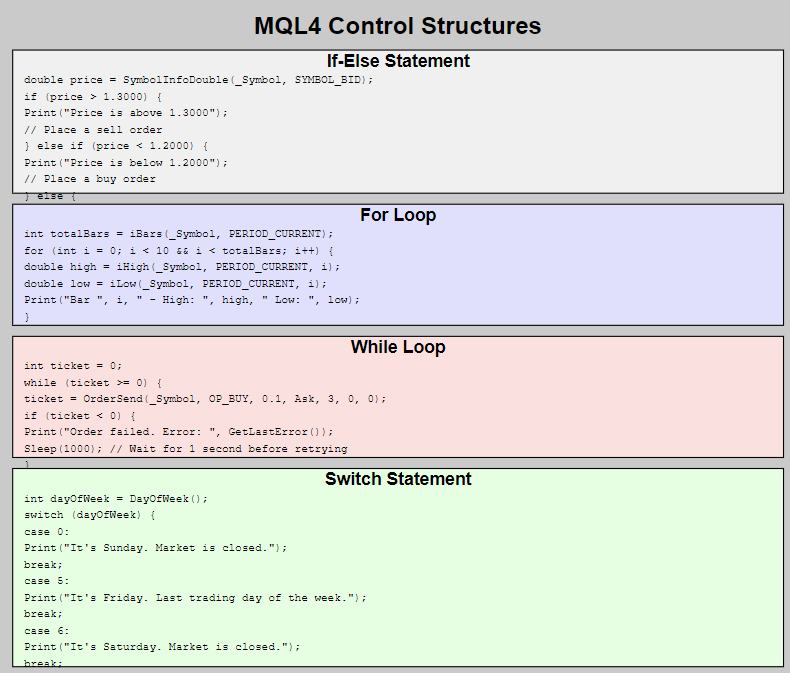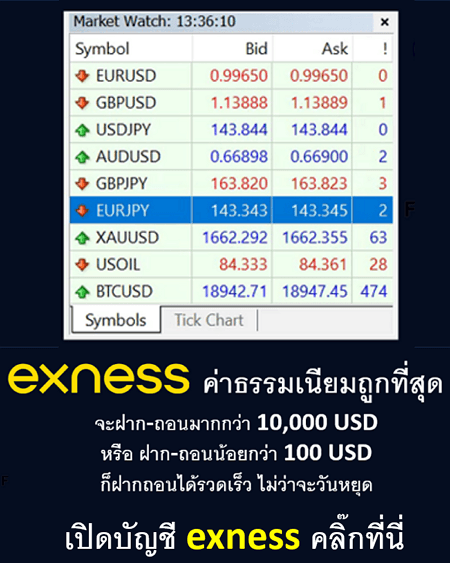ตัวอย่างการใช้งานโครงสร้างควบคุม (if-else, loops, switch)
โครงสร้างควบคุมเป็นส่วนสำคัญในการเขียนโปรแกรม MQL4 ที่ช่วยให้เราสามารถควบคุมการทำงานของโปรแกรมได้อย่างมีประสิทธิภาพ

ลองมาดูตัวอย่างการใช้งานโครงสร้างควบคุมแบบต่างๆ กัน:
1. if-else statement
ใช้สำหรับตัดสินใจทำงานตามเงื่อนไขที่กำหนด
void CheckAndTrade()
{
double currentPrice = MarketInfo(Symbol(), MODE_BID);
double ma20 = iMA(Symbol(), 0, 20, 0, MODE_SMA, PRICE_CLOSE, 0);
if(currentPrice > ma20) {
Print("Price is above MA20. Considering a buy order.");
// เพิ่มโค้ดสำหรับเปิดคำสั่งซื้อที่นี่
}
else if(currentPrice < ma20) {
Print("Price is below MA20. Considering a sell order.");
// เพิ่มโค้ดสำหรับเปิดคำสั่งขายที่นี่
}
else {
Print("Price is equal to MA20. No action taken.");
}
}
2. for loop
ใช้สำหรับทำงานซ้ำๆ ตามจำนวนรอบที่กำหนด
void CalculateAveragePrice()
{
int periods = 10;
double sum = 0;
for(int i = 0; i < periods; i++) {
double closePrice = iClose(Symbol(), 0, i);
sum += closePrice;
Print("Close price ", i, " periods ago: ", closePrice);
}
double average = sum / periods;
Print("Average price over last ", periods, " periods: ", average);
}
3. while loop
ใช้สำหรับทำงานซ้ำๆ ตราบใดที่เงื่อนไขยังเป็นจริง
void CloseAllOrders()
{
while(OrdersTotal() > 0) {
for(int i = OrdersTotal() - 1; i >= 0; i--) {
if(OrderSelect(i, SELECT_BY_POS, MODE_TRADES)) {
bool result = OrderClose(OrderTicket(), OrderLots(),
MarketInfo(OrderSymbol(), MODE_BID), 3, clrRed);
if(result) {
Print("Order closed successfully: ", OrderTicket());
}
else {
Print("Failed to close order: ", OrderTicket(),
". Error: ", GetLastError());
}
}
}
}
Print("All orders have been closed.");
}
4. do-while loop
คล้ายกับ while loop แต่จะทำงานอย่างน้อยหนึ่งครั้งก่อนตรวจสอบเงื่อนไข
void AdjustStopLoss()
{
double newStopLoss;
bool success;
do {
newStopLoss = NormalizeDouble(Bid - 20 * Point, Digits);
success = OrderModify(OrderTicket(), OrderOpenPrice(), newStopLoss,
OrderTakeProfit(), 0, clrGreen);
if(!success) {
Print("Failed to modify order. Error: ", GetLastError());
Sleep(1000); // รอ 1 วินาทีก่อนลองใหม่
}
} while(!success);
Print("Stop loss adjusted successfully to ", newStopLoss);
}
5. switch statement
ใช้สำหรับเลือกทำงานตามค่าที่กำหนด
void HandleTradeSignal(int signal)
{
switch(signal) {
case 1:
Print("Strong buy signal detected.");
// เพิ่มโค้ดสำหรับเปิดคำสั่งซื้อที่นี่
break;
case -1:
Print("Strong sell signal detected.");
// เพิ่มโค้ดสำหรับเปิดคำสั่งขายที่นี่
break;
case 0:
Print("Neutral signal. No action taken.");
break;
default:
Print("Invalid signal received.");
}
}
6. การใช้โครงสร้างควบคุมร่วมกัน
ต่อไปนี้เป็นตัวอย่างการใช้โครงสร้างควบคุมหลายแบบร่วมกันในสถานการณ์จริง:
void ManageOpenPositions()
{
for(int i = OrdersTotal() - 1; i >= 0; i--) {
if(OrderSelect(i, SELECT_BY_POS, MODE_TRADES)) {
if(OrderType() <= OP_SELL) { // เช็คว่าเป็น market order double currentProfit = OrderProfit(); if(currentProfit > 0) {
if(currentProfit >= OrderOpenPrice() * 0.01) { // ถ้ากำไร 1% ขึ้นไป
bool result = OrderClose(OrderTicket(), OrderLots(),
MarketInfo(OrderSymbol(), MODE_BID), 3, clrGreen);
if(result) {
Print("Profit target reached. Order closed: ", OrderTicket());
}
else {
Print("Failed to close profitable order. Error: ", GetLastError());
}
}
}
else if(currentProfit < 0) { if(MathAbs(currentProfit) >= OrderOpenPrice() * 0.02) { // ถ้าขาดทุน 2% ขึ้นไป
bool result = OrderClose(OrderTicket(), OrderLots(),
MarketInfo(OrderSymbol(), MODE_BID), 3, clrRed);
if(result) {
Print("Stop loss reached. Order closed: ", OrderTicket());
}
else {
Print("Failed to close losing order. Error: ", GetLastError());
}
}
}
}
}
}
}
ในตัวอย่างนี้ เราใช้ for loop เพื่อวนลูปผ่านทุกออเดอร์ที่เปิดอยู่ ใช้ if statements เพื่อตรวจสอบเงื่อนไขต่างๆ และตัดสินใจว่าจะจัดการกับแต่ละออเดอร์อย่างไร
การเข้าใจและใช้งานโครงสร้างควบคุมอย่างมีประสิทธิภาพจะช่วยให้คุณสามารถสร้าง EA ที่มีความซับซ้อนและยืดหยุ่นมากขึ้น สามารถจัดการกับสถานการณ์การเทรดที่หลากหลายได้

FOREXDUCK (นามปากกา) นักเขียนของเรามีประสบการณ์การเงินการลงทุนกว่า 10 ปี มีความเชี่ยวชาญในการวิเคราะห์ตลาด Forex และคริปโต โดยเฉพาะการวิเคราะห์ทางเทคนิค รวมถึงเทคนิคต่าง

